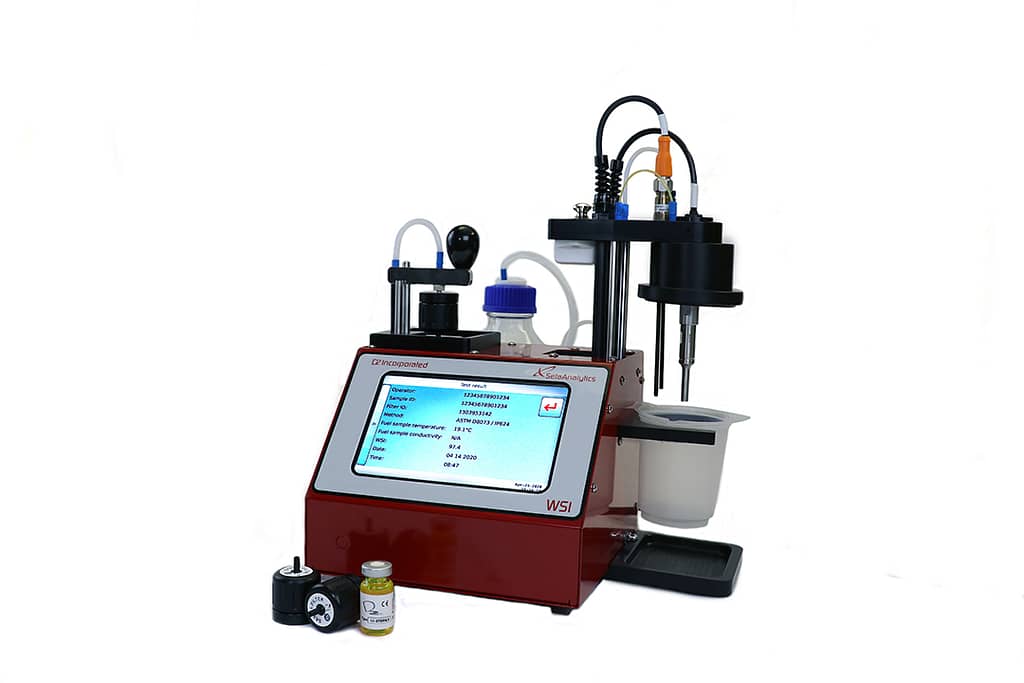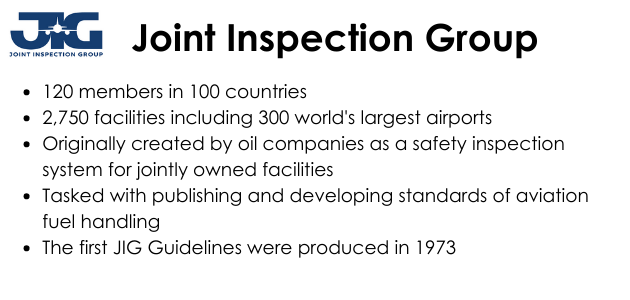Joint Inspection Group (JIG) has released a new bulletin no. 142…
TESTING WATER SEPARATION PROPERTIES OF JET FUEL DOWNSTREAM OF POINT OF MANUFACTURE (REVISED MSEP PROTOCOL) – This protocol supersedes JIG Bulletin 129
1) The preferred method for testing fuels containing a Static Dissipator Additive [SDA] downstream of the Point of Manufacture is ASTM D8073
2) ASTM D3948 can continue to be used as part JIG Standards (for example as part of Recertification testing and Certificate of Analysis)
Full JIG Bulletin 142 Report here: Bulletin-142-Testing-Water-Separation-Properties-of-Jet-fuel-Revised-MSEP-Protocol-04_2022

REVISED JIG PROTOCOL FOR WATER SEPARATION TESTING DOWNSTREAM OF POINT OF MANUFACTURE EFFECTIVE APRIL 2022
Where water separation performance testing is conducted downstream of point of manufacture in facilities operating to the JIG Standards, the following protocols shall apply.
1) Testing should be done using either
ASTM D7224 with a minimum limit of 85, or
ASTM D8073 (IP624) with a minimum limit of 88.
Note that for fuels containing an SDA the preferred method is ASTM D8073, and ASTM D7224 is not recommended.
Despite the uncertainty with some fuels as explained above, these methods are the preferred methods for testing downstream of the point of manufacture, as they have improved precision relative to MSEP (ASTM D3948).
Alternatively, testing may also be conducted using ASTM D3948 (it is noted that JIG still intends to withdraw this method in the future).
If the results are between 60 and 70, a confirmation test shall be run of the original sample. Provided the two test results are within the repeatability of the ASTM D3948 method, enter the average MSEP result from the two tests onto the test certificate. Subject to all other properties meeting specification requirements the certificate can be issued. The Batch may be released without recourse to other fuel suppliers involved at the location concerned, subject to local procedures. The local Re-certifying authority shall endorse the certificate. “MSEP result within precision limits of the test method”. All fuel suppliers at the location should be advised of this occurrence retrospectively.
If the result of ASTM D3948 testing is less than 60, a test shall be run on the original sample using either ASTM D7224 or ASTM D8073 (IP624). If the result of the test is greater than 85 for ASTM D7224 or 88 for ASTM D8073 (IP624), this result shall be entered onto the test certificate. Subject to all other properties meeting specification requirements, the certificate can be issued. The Batch may be released without recourse to other fuel suppliers involved at the location concerned, subject to local procedures.
If the initial result for ASTM D7224 or ASTM D8073 (IP624) is below the stated minimum limit for these tests shown under item 1 or 2b above, the protocols detailed in EI/JIG 1530 Annex E should be followed, to establish the final result before quarantining the fuel pending an investigation to determine the source of the failure.
A useful part of the investigation should be to carry out a test on the same sample with the
other test method listed in 1 above before quarantining the fuel. Results for a sample which has a “pass” result for one method but a “fail” result by the other should be reported to the JIG Product Quality Committee
Where the source of failure cannot be identified after investigation, remediation actions such as, but not limited to, clay treating or dilution may be used to achieve the required minima for ASTM D7224 or ASTM D8073 (IP624). (Note that clay treatment and/or dilution may result in loss of electrical conductivity in the fuel batch, which may need subsequent correction by redosing SDA.)
Where remediation is not feasible the product shall be downgraded.
Throughout transfers of fuel associated with batches released under this protocol, special care should be taken to ensure that water draining is done in accordance with the operating standards in effect at the location, either JIG 1/2 or EI/JIG 1530, to further ensure that the fuel is free of excess water and dirt when delivered into aircraft.
Subject to the endorsement of all fuel suppliers at a specific location, the above protocol shall be advised to their recertification laboratory(s) for automatic implementation. However, ensuring the integrity of Jet Fuel is at all times the paramount consideration, nothing in this protocol shall be deemed to override this principle. Fuel suppliers retain the right, in the absence of positive evidence of an investigation and any subsequent suitable corrective/preventative action, to ultimately withdraw their support for the use of this protocol.
Although it remains permissible at this point, it is the intention of JIG, at some future date, to withdraw the use of ASTM D3948 as a product quality control method downstream of refineries. This withdrawal will be the subject of a future bulletin, which will be published in due course.

